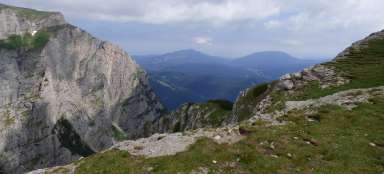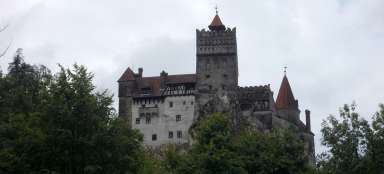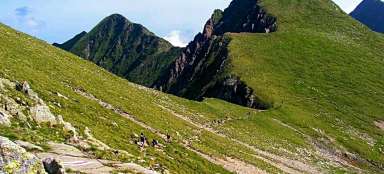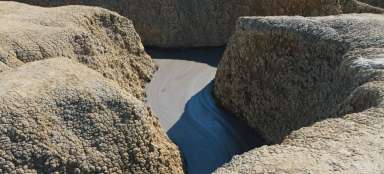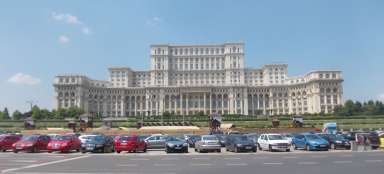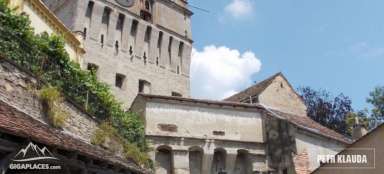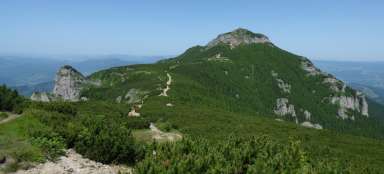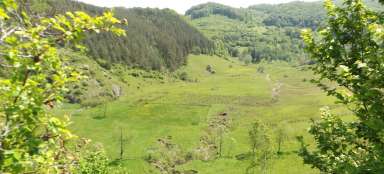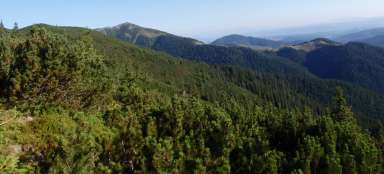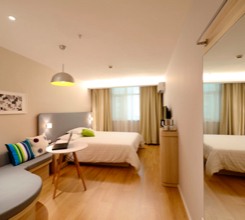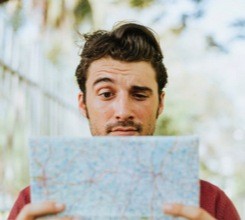Part 4. Fagaras, Peles, Pelisor and Brasov.

Here I will take you to three castles, one fortress in the center of a big city.
Day 4
Interesting places of the Carpathian massif.
I travel to Fagaras by the same passenger train with cracked windows as in the morning. Please do not confuse with the Fagaras Mountains, it lies about 20 km south of the city and the famous Transfagaras road begins about 30 km west of the city. After all, there isn't even time for the mountains, I'm going because of the fortress. However, I had such a difficult moment at the station, as it sometimes happens to a person. And so I entered an old cracked wooden door into a room with a toilet sign. The fee was 3 Lei (about 15 CZK), but they were probably the worst toilets I have ever encountered on my travels. After the payment, the lady waved her hand, which made me understand that the gentlemen were closed and I had to go to the ladies. That would not matter so much, even the presence of only „Turkish“ hookers in these parts can be assumed. Not only did the cabin door not lock, they did not close. Because „if you have to, then you have to,“ everything turned out well in the end, even though I didn't really see much difference between the paid toilets and the bushes that were around. Well, nothing, I'm going to get to know each other. You won't find many monuments in Fagaras, basically after about 1.5 km on the way to the city center, a rather uninteresting suburban district, I come across two only interesting places in the place. On the one hand it is the beautiful cathedral of St. George and on the other hand it is a fortress. Admission is not expensive 10 LEI (about 55 CZK) and the exhibition is located on three floors. The fortress survived 15 sieges from the beginning of the 16th century to the middle of the 19th century, it also served the Austrian, Hungarian and Romanian armies and for a short time also for the ruling communist party. You will complete the entire tour yourself, with a plan of the fortress, which you will receive at the box office. After a tour of the inner, but also the outer, by which I mean the surroundings of the fortress, which surrounds the moat with birds, I return to the station and a person to Brasov. The next day (the last of my stay) I plan Sinaiu and Busteni with several locks. At the Brasov railway station, I'm looking for a luggage room again, because the bus leaves me at 11 pm in the evening and I didn't want to spend the whole day with a big backpack on my back and I'm sitting in a passenger direction in the direction of Bucharest. I get off at a small train station in the mountain resort of Sianaia. Not far from the station are the lower stations of the cable cars to the top of Furnica, which exceeds the 2000-meter border by another 100 meters. But that doesn't interest me so much today, I go up the hills to the castles of Peles and Pelisor. They are about 2 km from the station at an altitude of almost 900 meters. After a little wandering, I find both castles in a wooded landscape above the town. Both Peles and Pelisor were built by King Charles I of Romania, Peles as his residence and Pelisor as a residence for his nephew and heir to the throne. Both were built at the turn of the 19th and 20th centuries, and both are currently accessible. The Czech footprint is left here by the architect Karel Líman, who designed Pelisor and participated in its completion in the Peléš chateau. I did not inspect Pelisor Castle due to time constraints. Admission there is 20 Lei. This Peles castle is expensive, even by our standards. Admission is 30 LEI one floor, if you want both dump 60 LEI, which is about 330 CZK. And beware, photography is at an additional cost, which I unfortunately only found out inside the castle. The organization was a bit haphazard here, there were supposed to be two queues, one for organized tours and the other for individuals, but there were organized tourists in both and once in a while a guide ran out and gave his sheep information about the tour, unfortunately at the time of my visit. citizens of Spain and Belgium, so I didn't know anything. However, one Belgian participant with whom I spoke smuggled me inside, saying that he would translate for me into English. In the end, there was no need, because before everyone lined up, there was an individual interpretation in English. Then I realized that tourists still run from one guide to another, as it suits them, and I adapted. And from the visitor circuit you will be captivated, for example, by Líman's Holul de Onorare, ie a hall over three floors with carved paneling, an imperial suite or a large armory. After a tour of the castle, I fall with a shortcut in the form of a walking path, along which other crowds of tourists come, to the station. I have a short drive to the next Busteni. It is only about 8 km, but if I can recommend do not drive the express train. The surcharge is more expensive than the trip itself and you get to 60 crowns. I tried a private train that runs twice a day from Bucharest to Brasov and I boarded a French train from the turn of the 60's and 70's. Průvočí wanted 4 Lei for me, but I didn't get a ticket. Holt extra income is needed. The drive to Busteni takes about 15 minutes. Cantacuzino Castle, where I am heading, can be seen before arriving at the station on the right-hand side of the train. The journey to the castle from the station also takes about a quarter of an hour. Admission is paid to the park around the castle, or you can pay for a tour of the interiors, which also contains an interesting collection of heraldry. The castle was built in 1911 at the request of Prince Cantacuzino in the neo-Romanesque style. Even a tour of the park with fountains and a view of the opposite massif of the Carpathian Bucegi Mountains is worth it. After returning to Busteni, I did not forgive myself for the Romanian specialty, namely Ciorba Biurta soup. It is actually similar to our tripe soup, it is just white and is served with pastries and a strong garlic paste. Well, it's true that then it didn't matter what I ate, because I smelled garlic in everything for three days, but otherwise it was delicious. I'm going back to the station. The town of Busteni once had another interesting thing, and that is the old electric groove to the local paper mill. Unfortunately, progress in Romania is sometimes too fast, so there are only remnants of the body, columns and a monument in the form of an electric locomotive and one wagon along the groove. However, the monument already bears quite significant traces of vandalism. I return by train to Brasov, and since there is still a lot of time before the bus leaves for Budapest, I go for a walk through Brasov. Brasov is a city of almost 300,000, above which rises the almost 1000 meters high mountain Tampa, which can be easily reached by cable car. The huge name of the town is also erected on this mountain. The historic center is about 2 km southeast of the station. You can get there by public transport, but I walk. It also immediately confirms what my Romanian colleagues from work told me, it rains in Brasov almost every day for almost a day. So on Strada Republica I hide under the pergolas of local shops. Fortunately, it stops very quickly and I come to the square, which is dominated by the town hall building with a regional museum in the middle and a fountain. I run through a small alley to the black church, the largest Gothic building in Southeast Europe, which was built between 1383 and 1477. I slowly begin to walk around the city center through the park around 2 gates, the first is called Kateřinina and is for pedestrians only, and the second is three-arched. which the middle arch is used for automobile traffic and is from 1827 and is called Schei. Another building that fascinated me is the Weaving Bastion with walls on the slopes of the aforementioned Tampa Mountain. On the walls of the bastion is the year 1421 – 1437, when construction began. I continue along the walls, past the lower station of the cable car, from where adventurous tourists are just coming out, and return to the building of the regional council, from where I started the circuit through the center. I have another ascent to the fortress of Brasov. I arrive late, around six o'clock in the evening, so it is closed, but the view of the city is also worth it. Originally there was a watchtower from the beginning of the 15th century, later a fortress was added. The year above the gate announces the year 1580, but after the fire of 1625 the whole fortress was completely rebuilt. For a time it also served as a prison and today it is a tourist attraction. The fortress is already closed, but the tents around it and the snack stalls suggest that there will be an event, a concert, just fun in the evening. I can't wait for that anymore, because I'm moving back to the station, where I'm picking up my backpack and taking the bus to the Bartolomeu bus station, from where my bus goes to Budapest late in the evening. Romania is a country of contrasts and also a country of great progress. After the revolution, many tourist places opened here, which are worth seeing. Unfortunately, there was little time, so maybe next time, for example, in another corner of Romania.
Peles Castle
The architecture of the castle fits perfectly into the local wooded landscape

Pelisor Castle
The neighboring Pelisor chateau, which is the work of the Czech architect Karel Líman

Fagaras Fortress
A fortress that, despite numerous raids, was never recharged.
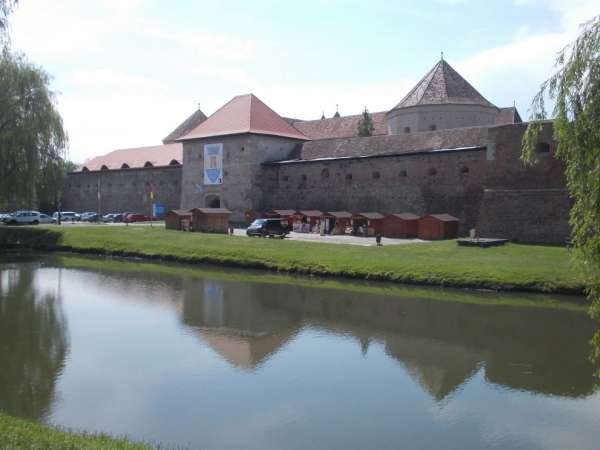
Fagaras - Cathedral of St. George
The beautiful cathedral is the second interesting place of Fagaras
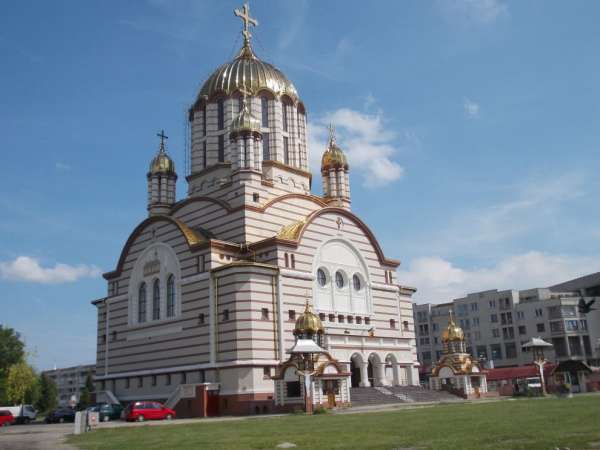
Brasov
View of the city from the Brasov fortress and the opposite mountain Tampa with an „advertisement“ of Brasov.

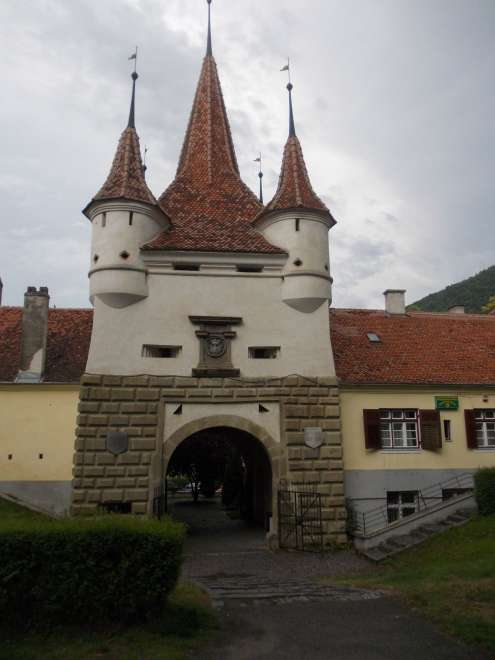
Catherine's Gate in Brasov
One of the two preserved gates on the western edge of the city center




